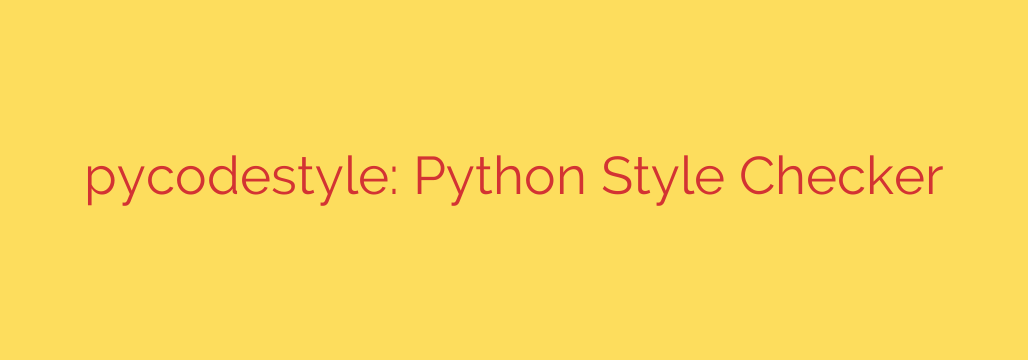
Write Cleaner, More Professional Python Code: A Guide to pycodestyle
In the world of software development, writing code that simply works is only half the battle. Writing code that is clean, readable, and consistent is what separates amateur programmers from seasoned professionals. For Python developers, the gold standard for code style is PEP 8, the official style guide for Python code.
But how can you ensure your code consistently adheres to these guidelines, especially when working on large projects or with a team? The answer is automation. This is where pycodestyle, a powerful and essential tool for any Python developer, comes into play.
What Is pycodestyle and Why Should You Use It?
pycodestyle is a command-line tool that checks your Python code against the style conventions laid out in PEP 8. You may have also heard of it by its former name, pep8, but the project was renamed to avoid confusion with the style guide itself.
Think of it as a friendly but strict code reviewer that automatically points out stylistic issues. It doesn’t check for logical errors or bugs, but it enforces a consistent format that brings several key benefits:
- Improved Readability: Code is read far more often than it is written. Following a consistent style makes it dramatically easier for you (and others) to understand, debug, and modify your code in the future.
- Enhanced Collaboration: When everyone on a team follows the same style guide, code reviews become more efficient. You can focus on the logic and functionality of the code, not on trivial debates about whitespace or line length.
- Easier Maintenance: Clean, well-formatted code is inherently easier to maintain and build upon. It reduces technical debt and makes your codebase more professional and sustainable.
Getting Started with pycodestyle
Integrating pycodestyle into your workflow is incredibly simple.
1. Installation
First, you’ll need to install it using pip, Python’s package installer. Open your terminal or command prompt and run:
pip install pycodestyle
2. Basic Usage
Once installed, you can run pycodestyle on any Python file or directory. To check a single file, use the following command:
pycodestyle my_script.py
To check all Python files within a project directory, simply point it to the directory:
pycodestyle my_project/
The tool will then scan the code and print any violations to your console, including the file name, line number, column number, and a specific error code with a description. For example, you might see an output like this:
my_script.py:18:1: E302 expected 2 blank lines, found 1
my_script.py:25:80: E501 line too long (92 > 79 characters)
This output is highly actionable, telling you exactly where to find and fix the style issues.
Customizing pycodestyle for Your Needs
While PEP 8 provides excellent defaults, sometimes you need to adjust the rules for a specific project. For example, the 79-character line limit can be a point of contention. pycodestyle is flexible and allows for easy customization.
Ignoring Specific Errors
You can tell pycodestyle to ignore certain error codes using the --ignore flag. This is useful for silencing warnings that your team has agreed to disregard.
# Ignore errors for long lines (E501) and missing newlines at end of file (W292)
pycodestyle --ignore=E501,W292 my_project/
Using Configuration Files
For project-wide consistency, managing these settings via a configuration file is the best practice. pycodestyle automatically looks for configuration in files like setup.cfg, tox.ini, or .pycodestyle.
Simply create a file named setup.cfg in your project’s root directory and add a [pycodestyle] section to it:
[pycodestyle]
ignore = E501, W292
max-line-length = 99
With this configuration file in place, you no longer need to pass command-line flags every time. Running pycodestyle my_project/ will automatically apply these custom rules.
Integrating pycodestyle into Your Development Workflow
The true power of pycodestyle is realized when it becomes an automated part of your development process. Here are a few ways to do that:
- Code Editors: Most modern code editors, like VS Code or PyCharm, have extensions or built-in functionality to integrate linters like
pycodestyle. This provides real-time feedback, highlighting style violations as you type. - Pre-Commit Hooks: You can set up Git hooks that automatically run
pycodestyleon your code before you commit it. This prevents stylistically inconsistent code from ever entering your repository. Thepre-commitframework is an excellent tool for managing this. - Continuous Integration (CI): Add a
pycodestylecheck as a step in your CI pipeline (e.g., GitHub Actions, GitLab CI). This ensures that all code merged into your main branch meets the required style standards, acting as a final quality gate.
Final Thoughts
Adopting a consistent code style is a hallmark of a disciplined and professional developer. Tools like pycodestyle make enforcing this standard effortless. By automating style checks, you free up valuable time and mental energy to focus on what truly matters: building robust, functional, and high-quality software.
If you’re not already using a linter, make pycodestyle the next tool you add to your Python toolkit. It’s a small change that will have a massive impact on the clarity, maintainability, and professionalism of your code.
Source: https://www.linuxlinks.com/pycodestyle-python-style-guide-checker/








